Hedgehogs
Caroline
French had three baby hedgehogs in the garden last
night. They were on their own feeding so this
obviously wasn't their first outing. Early this
morning Caroline also saw an adult disappear into the
Ivy at the bottom of the garden. Caroline recently saw
an adult collecting leaves to make a nest, but she
says these hoglets are too advanced to have been the
product of that nest-building effort. She will let us
know of any further developments. She tried to get
photos last night but the hoglets just went into a
ball, which doesn't make for a good photo! They were
very cute to see though.
SUNDAY
AUGUST 27 - 2017
Goshawk
sighting!
Chris
Berners-Price thinks he saw a Goshawk in Southleigh
Forest this morning! He says, "I have seen something
unusual before, but this time I got a good look at it
- a falcon with pointed wings, the size of a Buzzard
and solid blue/grey tops to the wings, weaving at
speed through the pines. My dog put it up from the
ground this morning and it flew up to a tree then gave
me a full plan view of it's wings as it perched. I am
pretty certain that it is not a female Sparrowhawk, it
is significantly bigger."
Chris attached a map showing the exact location where
he saw the bird. As Goshawk is a schedule 1 species, I
have decided not to publish Chris's map, but simply
say he saw the bird in the Gunter's Stone area to the
north of the forest close to Woodberry Lane. If you
happen to be in that area let me know of anything you
see resembling a Goshawk.
Goshawk is notoriously
difficult to distinguish from a large Sparrowhawk,
though the female Goshawk is up to Buzzard size. The
male is more the size of the female Sparrowhawk. Their
plumage is similar, though behaviour, particularly in
flight, differs. Although widespread on the continent,
the Goshawk is rare in this country having been
largely wiped out in the 19th C by persecution and
deforestation. However, it is recovering thanks to
recolonisation. The Hampshire Bird Atlas states that
Goshawk is an increasingly common resident of the
larger forests, especially the New Forest. More
significantly for today's sighting, is the Sussex Bird
Report for 2015 which reports up to 4 or 5 breeding
pairs in West Sussex! So, there is hope!
I don't have a photo
of a Goshawk in my files, but here is one I got from
the internet, but you really need to consult your bird
ID book for guidance on identification.

By Norbert Kenntner, Berlin
FRIDAY
AUGUST 25 - 2017
Grey
Mullet
I had a walk
around Slipper Millpond this morning and noted large
numbers of young Grey Mullet fish swimming around in
the shallow water near the western edge of the pond.
Most were no larger than 6 inches in length though
they grow considerably larger as they mature. Mullet
are slow growing and long living fish, often being
9-12 years before being fully mature when they are
about 18 inches long. Groups of large mature Grey
Mullett are very impressive when swimming Slipper
Millpond and Peter Pond.

Mullet are
predominantly a European species with their range
extending throughout the continent's waters. They are
found in most parts of the UK, but are most common in
the south and west. They live in calm waters, usually
around harbours, estuaries and marinas where they can
usually be seen (as in Slipper Millpond) swimming
slowly in shoals just below the surface of the water.
They are highly tolerant of brackish and stagnant
water and will swim some way up rivers. In Emsworth,
they are often seen in the lower reaches of the Lumley
Stream north of Peter Pond.
Harbour
Seals
While out
sailing, Alan and Sue Thomas were lucky enough to see
and get this nice photo of a large group of 23 Common
Seals on the sand banks in the Emsworth Channel.
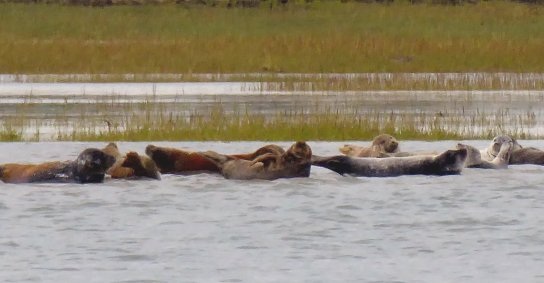
A number of Common
Seals (Phoca vitulina), also known as
harbour seals, live in the Solent and often visit
Chichester Harbour. Each one has unique markings and
their colourings can be different ranging from tan to
grey, black and brown. The females are generally
smaller but with a longer lifespan. The Chichester
Harbour Conservancy web site estimates the number of
harbour seals in Chichester Harbour at 23-25, with 18
being the most recorded at any one time.
For more information see . . . http://www.conservancy.co.uk/page/seals/375/
Autumn
Lady's Tresses
Having read
the blog entry (Aug 21) that Ralph Hollins reported
Autumn Lady's Tresses flourishing on Gurnard Point
Hayling Island, Jill Stanley went to see them for
herself this morning and got a few pictures. The ones
she found were mainly about 5 inches high or less, and
not that easy to spot, partly because of their size
and partly because they blended into the surrounding
vegetation, being green with white flowers. Jill's two
photos, one shows the white flower spike and the other
a close-up showing the general characteristics of
orchid flowers.
WEDNESDAY
AUGUST 23 - 2017
Brook
Meadow
I have made a
couple short walks through the meadow over the past
two days, mainly looking at leaves for insects and
spiders and there were certainly plenty of them to
see. I usually do my walks alone, but yesterday, for
some of the time, I was accompanied by a delightful
family from Hayling Island with two young children who
were on a 'nature hunt'. So I joined them as we walked
up the main river path to the north bridge. The young
boy, Sebastian, had a very impressive knowledge of the
insects we were looking at. It is so good to see
youngsters getting interested in the wildlife around
them. Here is a update on my best sightings.
Nursery-web
spiders (Pisaura mirabilis) were
widespread and fairly abundant on leaves. Most of them
were resting on leaves with their front legs stretched
out in front of them as shown on the left. On the
right is one I caught consuming a small fly
prey.
Here is another
Nursery-web spider carrying its white bundle of eggs
in her fangs. When the eggs are about to hatch she
attaches the cocoon to vegetation, spins a silken tent
over it and stands guard until the youngsters
disperse. Is this getting a bit late in the year for a
new brood?
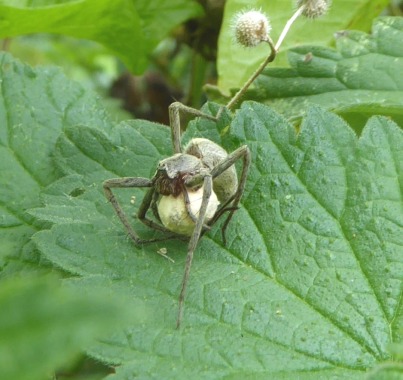
Shield Bugs came in a
variety of shapes, colours and sizes, which made
identification difficult. The green ones were probably
nymphs. I am inclined towards Dock Leaf Bug
(Coreus marginatus) for the adult brown
ones, but not with much confidence. Here are a couple,
but there were many more.
As expected there were
lots of Meadow Grasshoppers jumping around in
the grass and no doubt calling (which I cannot hear!),
though rarely stopping for a photo. The larger Dark
Bush-crickets are far more steady and photogenic.
This looks like a female with its long ovipositor for
egg-laying.
There were plenty of
hoverflies on the umbellifers. I think this one is
Myathropa florea. Honey Bees were also
feeding - here is a worker with bulging pollen sacs on
Common Fleabane.
Butterflies were
relatively scarce though I was pleased to catch up
with a female Green-veined White - part of the
summer brood which has heavily marked upper wings in
and faintly veined underwings (not visible in this
photo). I also got a Small White (female?)
feeding on Hoary Ragwort. What a valuable plant that
for late flying insects of all kinds. The female Small
White has a single spot on upper wing.
Here is a very ragged
Speckled Wood hardly recognisable and clearly
the worse for wear from its battles with weather.
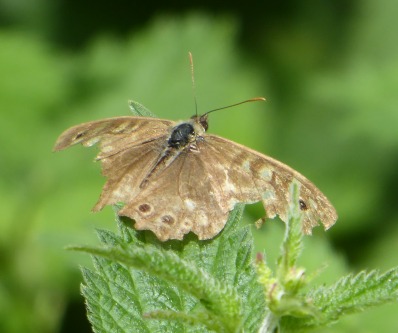
The only plant of
special interest was Thyme-leaved Speedwell in
flower on the Seagull Lane patch. This is a small but
always erect plant with oval leaves up the stem and
one or more flowers at the top. It is not a common
plant on the meadow; in fact, this is my first record
of this year. It is not particularly late as they
often carry on flowering into October.

There is a nice crop
of Elderberries on the Seagull Lane patch
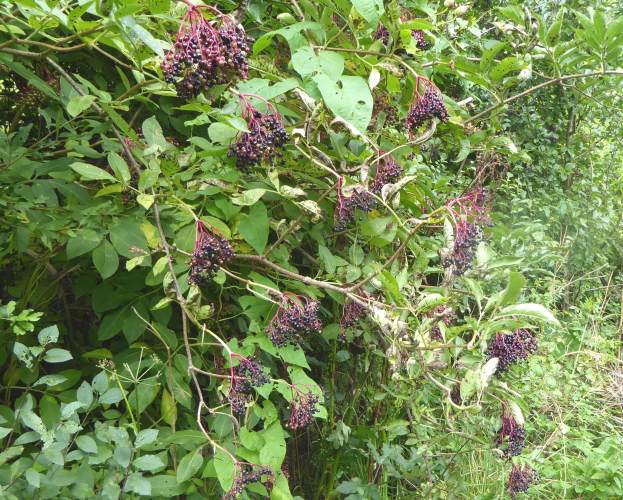
MONDAY
AUGUST 21 - 2017
Brook
Meadow
I had a walk
through the meadow this morning in light drizzle. The
tent has gone from Seagull Lane patch - removed by
Jennifer. Walking down the main river path, I looked
closely at the nettle leaves for any insects. Several
flowering spikes of Hedge Woundwort were pushing
through the dense nettle leaves.
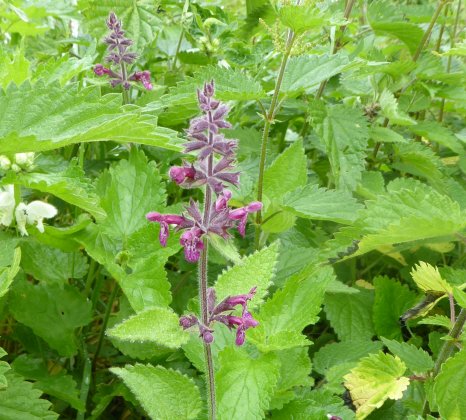
On the nettle leaves I
spotted a Harvestman (Daddy Long-legs) with a
Nursery-web spider close by.
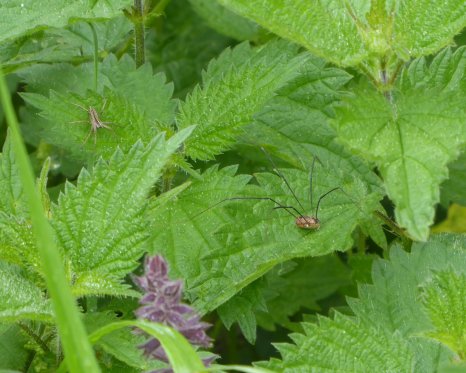
Several ginger
Bumblebees (Bombus hypnorum?) were
feeding on the White Dead-nettle.

Peacock
caterpillars
My best find
of the morning was a mass of at least 100 jet black
Peacock caterpillars that were feeding on nettle
leaves on the west side of the main river path about
half way between the north bridge and the S-bend. Also
prominent were lots of black blobs on the leaves which
I assume are the excreta of the caterpillars.
The nests from which
the caterpillars came were nearby with the remains of
previous instars still visible.
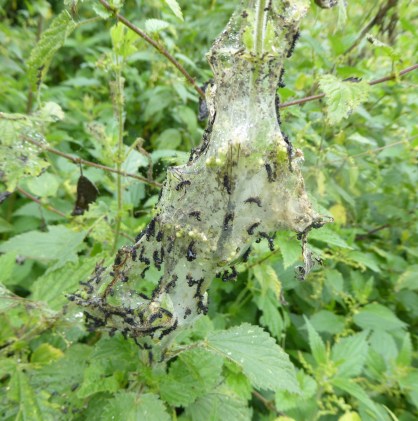
These caterpillars
seem quite late as the usual time for the larvae to
hatch is May to June. However, I gather pupation and
emergence of adults is quite quick, so the butterflies
could be on the wing by mid-September. This would give
them time to fatten up on late nectar sources before
settling down to hibernation somewhere warm and dry,
like a garden shed or a hollow tree.
South
bridge done?
It looks as if
work is finished on the south bridge, or has it? Only
the eastern approach appears to have been resurfaced,
leaving a rather rough area where it joins the bridge
itself which could be a trip hazard. Why was this not
done at the same time?
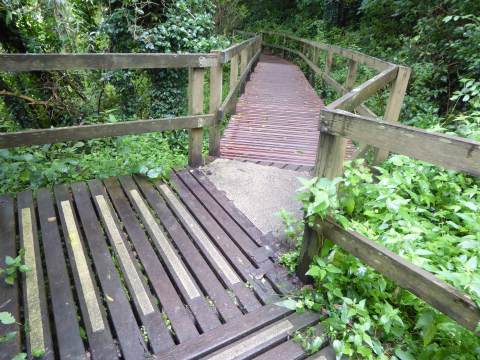
Autumn
Lady's Tresses
Yesterday (Aug
20) Ralph Hollins cycled to Gunner Point on SW Hayling
Island and found around 500 Autumn Lady's Tresses in
flower on the dunes. Here are Ralph's (abbreviated)
directions to get to the flowers: "Heading south from
the Ferry Inn I continued past the Ferry Sailing Club
and the sand dunes until the track veered round to
head east. Walking over the grass on the seaward side
of the main track I came on the first orchids in the
grass close to a small area of bare shingle surrounded
by grass. I found that more appeared with every step I
took. The Ladies Tresses continued to appear until I
was within 50 yards of the bench by the golf club
fence. I stopped counting the spikes when my tally had
reached 300 but estimate that the total was probably
500 or more which is more than I would expect to see
on Portsdown." See his blog for full details.
Here is the only photo
of Autumn Lady's Tresses that I have in my files,
taken by Richard Somerscocks at Noar Hill in Sept
2010.

SUNDAY
AUGUST 20 - 2017
BROOK MEADOW
Tent
I had an e-mail
from Maurice Lillie about a small blue tent pitched on
the Seagull Lane patch. Maurice could not speak
directly to the occupants, if any, but told the tent
loudly that they were not permitted to camp on Brook
Meadow as it is a Nature Reserve and asked them to
leave as soon as possible. This is probably the same
tent that I saw on Friday on the Interbridges Site. It
was still there when I went over at 1pm this
afternoon, at the far end of the patch next to the
small Oak sapling planted by Jean.
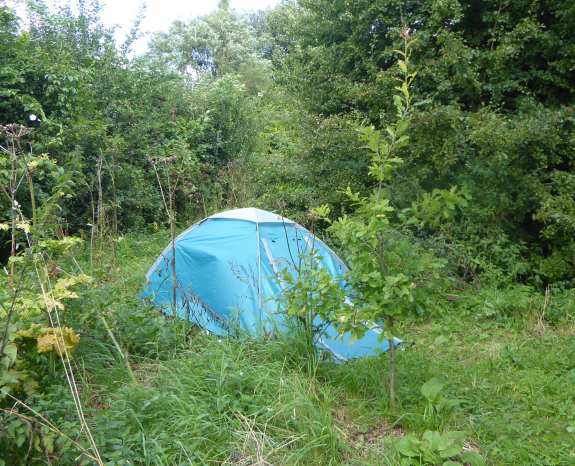
Late news: Jennifer
Rye informed me that she has removed the tent (and
associated rubbish) as it was clearly abandoned and
it's now rolled up in her garage pro tem. No
harm done, except that reptile mats had been stacked
underneath it and she can't return them to exact sites
they were on, so she's left them stacked. Jennifer
will inform the ecologists who put them out.
Common
Darter
I was pleased to
meet up with Paul and Carole Checksfield on the north
bridge. This was my first meeting with this local
couple, though I have previously corresponded with
Carole who contributed the photo of the Hedgehogs in
her garden for the blog on Aug 17. We had a chat about
the meadow and the Water Vole crisis. While we were
talking a superb male Common Darter landed on
the handrail of the bridge and remained long enough
for me to get a photo. These insects are so
photogenic.
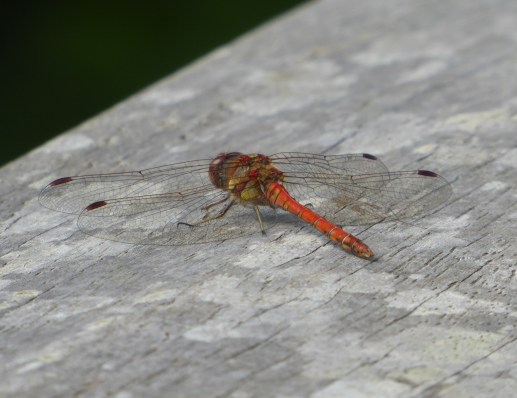
Interbridges
Site
I had a walk
around the Interbridges Site which is an area of
'wasteland' between the railway line and the A27 road
to the east of New Brighton Road. It is currently
awaiting light industrial development, though nothing
has happened as yet. I hope this situation continues
as the site has a glorious galaxy of wild flowers,
much too good to build on. Access onto the site is
easy through a gap in the fence from the path at the
end of Seagull Lane. There is a well trodden path
through the site, but no easy access at the other end
onto the New Brighton Road as far as I could see. This
is, of course, an extension of the Railway Wayside on
the other side of New Brighton Road. Here is a view of
the site looking west towards Emsworth Railway
Station.
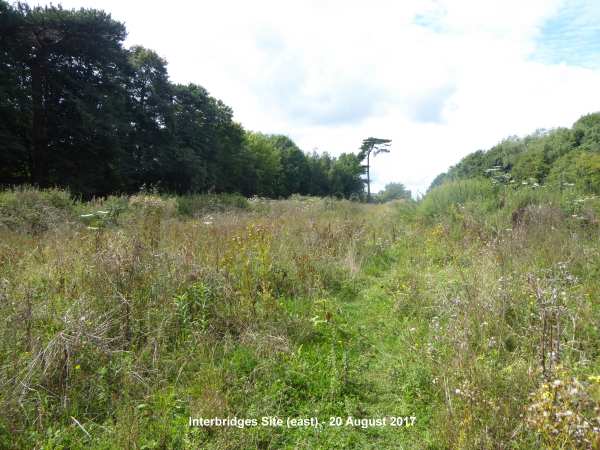
Here are some of the
plants I noted in flower from the path: Common
Fleabane, Stone Parsley, Common Ragwort, Hoary
Ragwort, Hogweed, Common Knapweed, Wild Angelica, Red
Clover, Yarrow, Canadian Goldenrod, Red Bartsia,
Bristly Ox-tongue, Scarlet Pimpernel , Creeping
Cinquefoil, Broad-leaved Willowherb, Guernsey
Fleabane, Daisy, Bramble.
Best of all was a particularly fine growth of
Perforate St John's-wort, with its red seed
heads just starting to develop. I picked a few stems
for my window desk display. I won't need to go to the
bridge over the A27 at Lumley which previously was the
only good place I knew for these attractive plants.
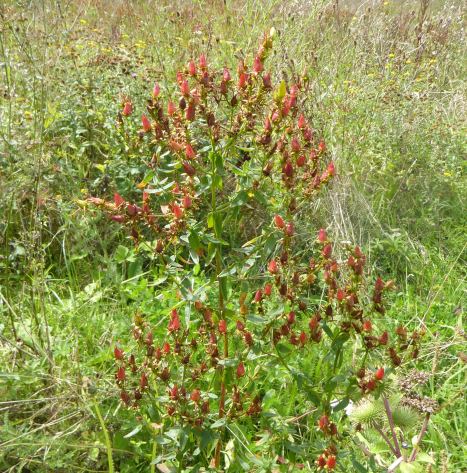
Wasp
Spider
I came across
a fine Wasp Spider (Argiope bruennichi)
on its web in the undergrowth on the Interbridges
Site. The Wasp Spider builds a large orb web usually
low down in grassland and attaches its silk egg sac to
the grasses. The web has a wide, white, zigzag stripe
running down the centre called a stabilimentum, but
its function is unclear. Its main food is
grasshoppers. Mating is dangerous for the male which
is much smaller than the female. It waits on the edge
of the web until the female has mounted into a mature
form then while her jaws are soft rushes in to mate.
Nevertheless males often get caught and eaten by the
female during this operation.
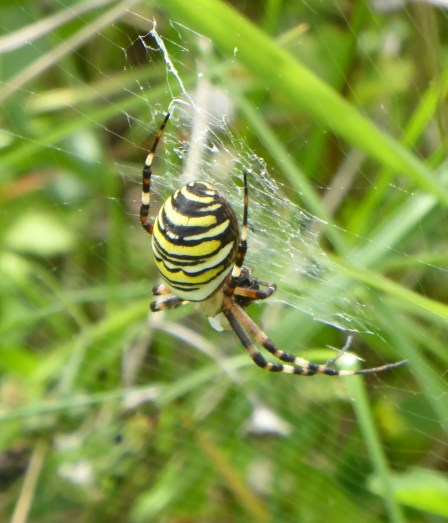
This distinctive
spider was first recorded in the UK in 1922 in Rye
having spread from the continent. Since then, it has
spread across the South of England where it is now
fairly common. Its distribution is largely
concentrated in the South and South East, but its
range is spreading northwards probably due to milder
winters. Its main habitat is unmanaged grassland as
any form of regular cutting of grassland will destroy
the webs and over wintering cocoons.
Burying
Beetle
Also on the
Interbridges Site, I followed a black beetle as it
scuttled around in the long grasses. It was distintive
in having two broad orange stripes across its body and
(for a beetle) it was surprisingly easy to identify in
the book as a Burying Beetle -
Nicrophorus spp - probably the Common
Burying Beetle (Nicrophorus vespillo),
though I stand to be corrected as there are several
very similar beetles. The antennae are clubbed, though
they cannot be seen in this photo.
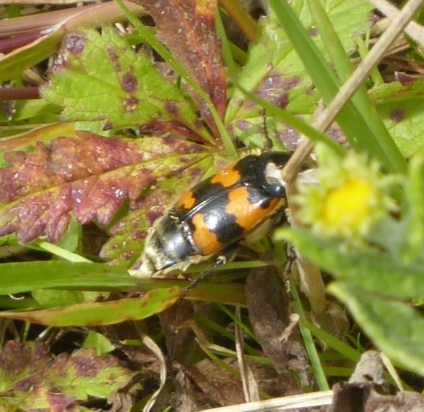
These ingenious
creatures bury small carcasses (much larger than
themselves, such as mice and birds), by digging a
shaft underneath them and hauling them down. The
female then lays eggs close to the buried corpse on
which the larvae feed. What an extraordinary world we
live in!
Hedgehog
news
Caroline
French had much excitement in her garden tonight when
she spotted a Hedgehog with a mouthful of leaves,
looking as if it is making a nest. She says this is a
bit late for Hoglets but let's see what
happens.
Emsworth
Harbour
Peter
Milinets-Raby was out early this morning looking at
the birds in Emsworth Harbour from 6:22am to 8:16am
with the tide slowly pushing in. Main
observations:
Emsworth Harbour: A Redshank with colour rings
(-//G + G//YG), 5 Greenshank, 2 Grey Plover, 13
Dunlin, 4 Little Egret, 12 Swallow, 25 Turnstone, 1
Great Black-backed Gull, 1 Ringed Plover, 1 Yellow
Wagtail flying over, briefly landed on the mill pond
wall, but I just could not find it before it flew off!
1 solitary Brent Goose out in the middle of the
harbour, 1 Common Tern, 118 Black-tailed Godwit (Y//R
+ W//-).
Brian's note: this colour-ringed Black-tailed
Godwit could be Y+WL - last seen in Emsworth on
25-Sep-12
Emsworth
Millpond: 4 Coot, 2 Cormorant.
Off Beacon Square: 22 Mallard feeding on the
mud, 1 Sandwich Tern, In the gardens, 4 Willow
Warblers, 2 Whitethroat and a Chiffchaff.
Nore Barn: 3
Greenshank (G//R + GG//-), 11 Black-tailed Godwit, 12
Mute Swan, 1 Great Black-backed Gull, 1 Kingfisher
perched on a yacht, 3 Whimbrel, 1 Dunlin.
SATURDAY
AUGUST 19 - 2017
Warblington
shore birds
Peter
Milinets-Raby was out this morning for a couple of
hours visiting the shore at Warblington (6am to 8:11am
- tide coming in). Main observations.
Warblington cemetery extension: 2 Green
Woodpecker.
Ibis Field: 2 Chiffchaff, 1 Jay, 1 Swallow.
Hedgerow behind Conigar Point: 1 Chiffchaff, 1 Sedge
Warbler, 1 Stock Dove.
Conigar Point: 1 Grey Plover, 2 Common Tern, 2 Little
Egret, 1 Whimbrel, 1 Snipe flushed by Kestrel, 9
Dunlin, 7 Ringed Plover, 1 Greenshank.
Off Pook Lane: 7 Grey Plover, 8 Dunlin, 14 Greenshank
(5 with colour rings RG//- +YY//- & G//R + YN//-
& G//R + LL//- & B//R + LO//- & GR//- +
YY//- ), 3 Common Tern.
Great Spotted Woodpecker flew over heading across the
water to Hayling, 7 Swallow, 2 Yellow Wagtail - yellow
adult over, then a dull, light brown juvenile landed
on the shore for a couple of minutes before flying on
- Autumn has truly arrived NOW! 1 Sandwich Tern, 9
Black-tailed Godwit.
Elephant
Hawkmoth
Malinda
Griffin had the good fortune to spot a Elephant
Hawkmoth caterpillar in Brook Meadow exploring leaf
litter for winter quarters. It winters as a pupa,
emerging as a beautiful pinkish moth from Mid May to
July.
Apologies for over exposed photo, but the creature is
easily identified from its huge eye-spots and long
trunk-like snout.
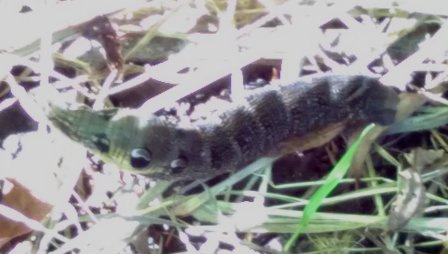
THURSDAY
AUGUST 17 - 2017
Brook
Meadow
I spent an
hour or so on the meadow this morning taking photos of
the regular work session. Rain overnight had left the
vegetation quite wet, but underfoot was still firm.
Seven volunteers attended and the session was led by
Maurice Lillie. The main tasks involved cutting and
clearing parts of the Seagull Lane patch and the south
meadow.
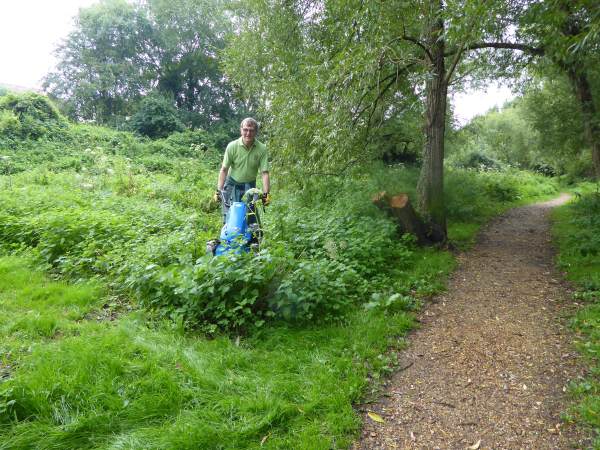
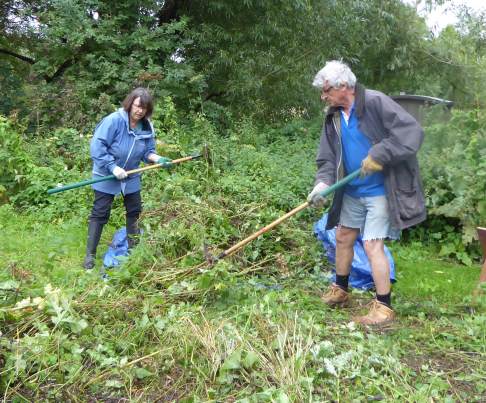
For a full report
on the work session with more photos go to . . .
http://www.brookmeadow.org.uk/conservation-news/
Other
observations
The
resurfacing of the north bridge is now complete and
looks very good. I checked on the south bridge where
work is ongoing. Here are the two Norse workers on the
site, both named Lee. They said the bridge should be
finished in a couple of days.
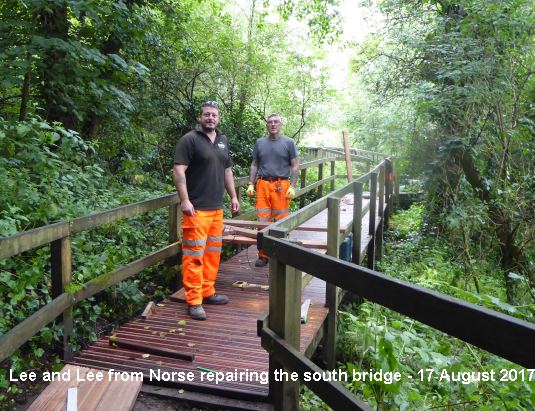
Gordon showed me a
Song Thrush nest that he and Maurice had
discovered on top of a fence post as they were
clearing some overhanging branches on the north west
plantation. Close up, the nest is an impressive
structure - a woven circle of small twigs, leaves,
grass, roots, moss and bits of string surrounds a
smooth inner cup of papier-mâché made
from rotten wood-pulp. Song Thrushes are fairly common
around the meadow, but it's good to have confirmation
of their nesting.
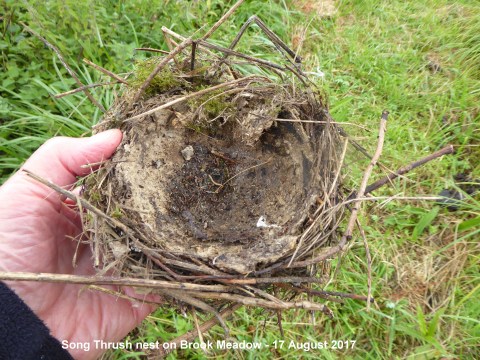
Grandchildren
on Brook Meadow
Jean and I
have been looking after two of our granddaughters
(Lily and Iris, aged 11 and 9), so I thought it would
be nice to take them over to the meadow to catch the
end of the work session before their lunch. They loved
it. The workday was just finishing so I introduced
them to some of the volunteers. They had a mock try
with the power scythe which Mike was in the process of
cleaning at the time!
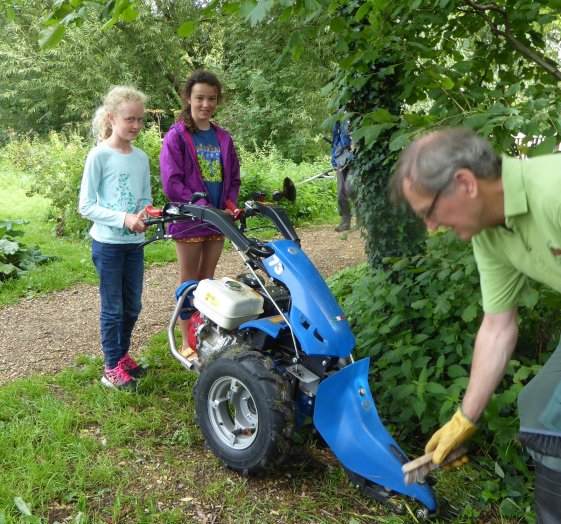
We had a look at the
young Oaks on the Seagull Lane patch. Lily measured
herself against the height of the smallest of the Oaks
that my wife planted in 2012.
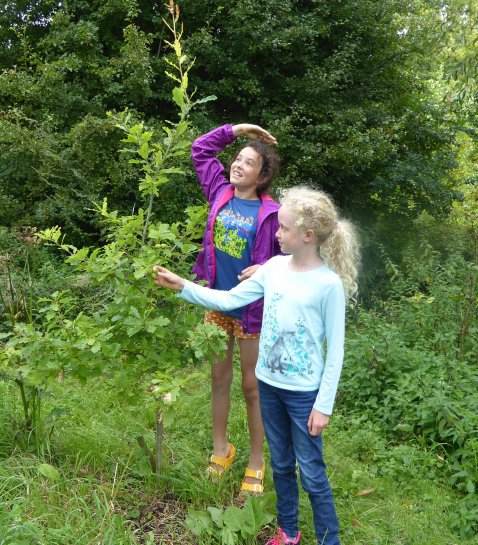
They were interested
to learn about the various galls growing on the trees
and were reassured to learn that they would not harm
the trees. On the left are some spangle galls on the
Oak leaves and on the right a Knopper gall.
We lifted a couple of
the reptile survey mats and found Slow-worms
underneath both of them.

I was astonished when
Iris complained of the noise of the
grasshoppers on the north meadow, something I
have never had the pleasure of hearing. Here they
mocked me by 'blocking their ears' to the noise!

Finally, they had a
sniff of Pineappleweed which they thought was
wonderful! Their first ever experience of smelling
this delightful plant.

More
Hedgehogs
Carole
Checksfield who lives in Sultan Road, Emsworth has had
some friendly Hedgehogs in her garden. She says they
started feeding them several years ago and they now
have five Hedgehogs, including what seems to be three
babies. Beautiful animals that are a joy to watch.
Carole would like to encourage others to put out a few
mealworms as Hedgehog numbers are decreasing and so
they need all the help they can get. Well said Carole.
Here is Carole's photo of two of the hogs that visit
her garden.
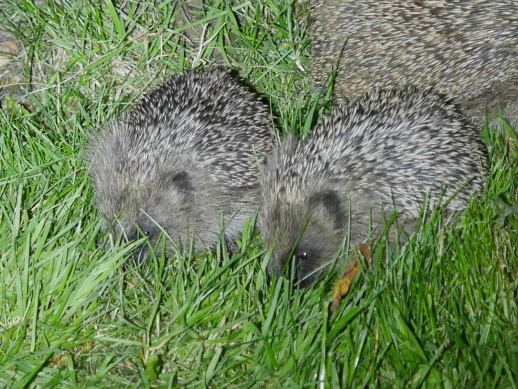
I had the nice
experience a couple evenings back while walking along
St James Road with my two granddaughters (Lily and
Iris) when a Hedgehog scuttled across the road in
front of us. It was their first ever sighting of a
Hedgehog. How wonderful!
Exploding
fungus
Chris Oakley
wonders what to make of this fungus which appears to
have exploded! He assumes it is some kind of Puffball
but they are usually full of powder spores. Does
anyone have an answer?
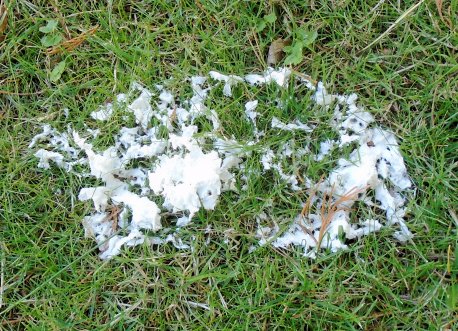
TUESDAY
AUGUST 15 - 2017
Langstone
Mill Pond
Peter
Milinets-Raby visited Langstone Mill Pond mid morning
on a very low tide (10:27am to 11:21am. The highlight
was a juvenile Peregrine that flew around for five
minutes, having a swoop at two different Little Egrets
and a couple of Oystercatchers, but failing to connect
on each occasion. It was acting as if it was just
practicing! He then landed on the low tide mud for a
couple of minutes before flying off over the Hayling
Bridge.
Other birds of note included: 2 Sandwich Tern, 4
Common Gull, 28 Dunlin, 110+ Redshank, 5 Black-tailed
Godwit, 4 Ringed Plover, 19 Med Gulls with 2 juvs (all
in winter plumage), 13 Little Egrets feeding in the
trickle of water in the channel, 4 Greenshank, 2 Grey
Plover - winter plumage.
Langstone Mill Pond: Tufted Duck female with seven
growing ducklings (see photo).
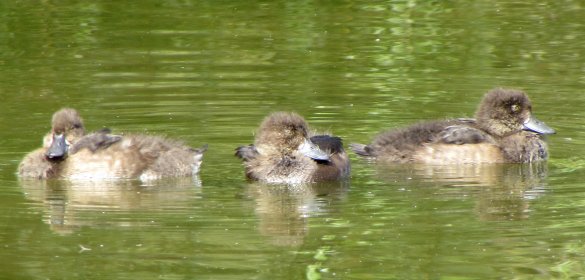
1 Little Grebe, 15
Little Egrets still loitering, with 2 half grown young
still in one nest.
Wood
Wasp
Brian Lawrence
had a walk in Southleigh Forest opposite Hollybank
Woods yesterday and got a photo of a Wood Wasp. These
wasps re easily recognisable from their strange shape,
rounded head, long neck, long black antennae and long
red legs. This one is probably Xiphydria
camelus which is widespread in woodland at
this time of the year, though not exactly common.

Chichester
art
I did not do
any wildlife today, but Jean and I had an interesting
day of art in Chichester. First, we went to see the
John Minton Centenary Exhibition at the Pallant
Gallery. Minton was a rather sad and tortured artist
who committed suicide aged 39. His art was not great,
but he was a fine illustrator and did a large number
of books and other things. His paintings included a
huge mural called 'Jamaican Village'.

A decorated table also
caught my eye, inspired apparently by his visit to the
Charleston farmhouse where the Bloomsbury artists
painted the furniture. Well worth a visit.
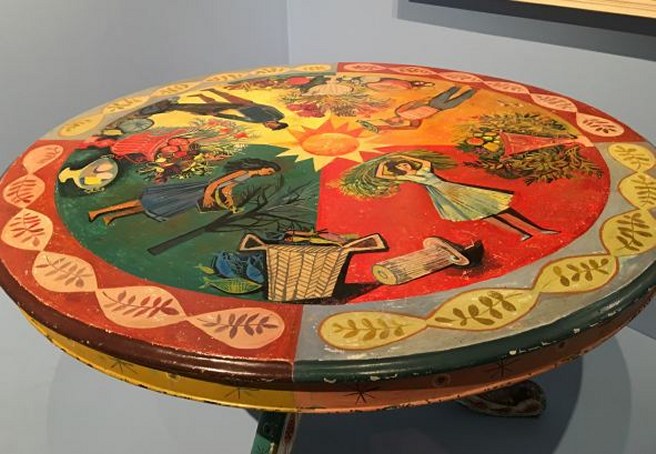
After lunch we had a
look around the Cathedral where I was bowled over by a
huge mural in the north transept containing 400
paintings done one every day by Frieda Hughes
(daughter of Ted Hughes and Sylvia Plath). I did not
know anything about this exhibition which has been on
since June 14 and finishes on Thursday 17 Aug,
so get along there if you are interested. The whole
exhibition is too good to miss. This photo of the
mural does not do it full justice. You really need to
see the thing.

Here is a sample of
what it looks like close-up.

MONDAY
AUGUST 14 - 2017
More
about wasps and flies
Following my
notes in yesterday's blog about distinguishing wasps
and flies, Bryan Pinchen wrote to say a much better
way to separate solitary (and social) wasps from the
flies is their always obvious (long) antennae.
Hoverflies don't appear to have any antennae at all.
As for how they hold their wings when at rest, Bryan
says not all hoverflies hold their wings out, as I
incorrectly indicated, some do hold them flat over the
body when at rest, so that is not a reliable
feature.
Bryan added that Ectemnius wasps are
quite widespread and common in most habitats and we
are just about hitting their peak flight season.
Hogweed and other umbellifers are a good place to see
them, being short of tongue the easily accessible
nectar is what they're after, and any prey species
visiting too.
Bryan confirmed all the other insects photographed on
the blog all look OK. Wow. I can do it sometimes!
Railway
Wayside
I went looking
for solitary wasps on the wayside to the north of
Emsworth Railway Station, but did not see any obvious
ones, though there were plenty of hoverflies as usual.
I am not sure which this one is. I am going to have to
give up on these trying to identify these tiny insects
as it is doing my head in!
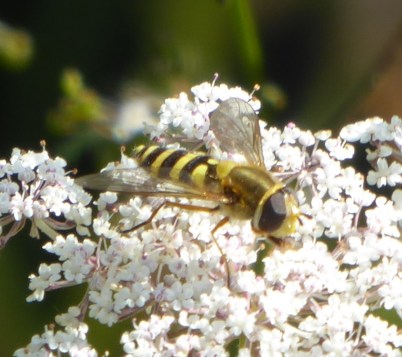
Butterflies are much
easier, particularly Common Blues which were
everywhere on the site. This white butterfly puzzled
me for a while, though I am fairly sure it is a female
Small White with two spots on the upper wings.
Its underwings were a dull pale yellow, though not
shown in the photo.
Waysides
walk
I had an
afternoon walk through the fields behind Westbourne
Avenue where I spotted the Dormouse Survey nesting
boxes still attached to the hedges. I have not heard
any more about this survey or the housing development
plans. I came back through the roads to check on the
Wild Clary in Christopher Way which still had a
few flowering spikes.

I was surprised to
find a single flower of Fox and Cubs in front
of the seat on the corner of Bellevue Lane and
Horndean Road outside St James Primary School. How did
it get there, I wonder?
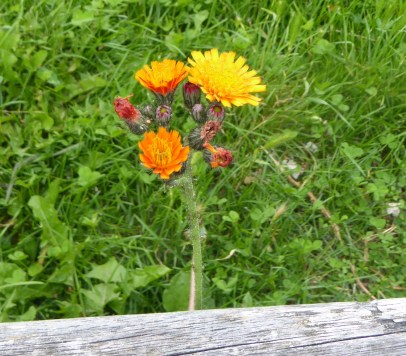
I was pleased to meet
up with Lesley Harris in Emsworth Recreation Ground.
Lesley used to be the Brook Meadow Conservation Group
secretary before she had to give up due to illness a
few years ago. She was on her daily walk to get her
health back and was looking good. She hopes to get
back to help on Brook Meadow fairly soon. I invited
her to have a cup of tea at home with me and Jean
where we had a good chat.
SUNDAY
AUGUST 13 - 2017
My
'flies' were wasps!
Bryan Pinchen
e-mailed to say what I called 'flies' feeding on
Hogweed in the blog for Aug 11 were, in fact, solitary
(digger) wasps in the genus Ectemnius,
either cavifrons or
cephalotes, but without a microscope
they are not easy to separate in the field. Here is my
original photo.
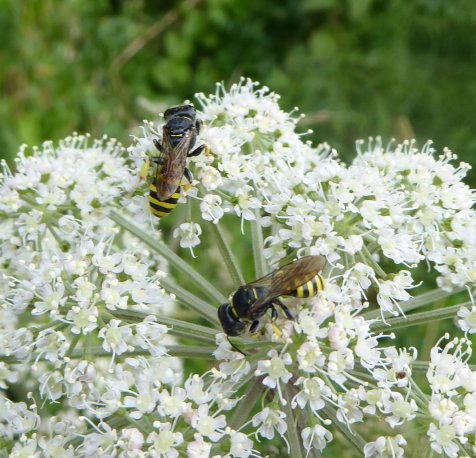
Ectemnius
are large attractive black wasps with bright yellow
abdominal markings and there are 10 species in Britain
and Ireland.
They are part of a larger family of digger wasps
(Crabronidae formerly
Sphecidae) of which 118 species are
present in Britain and Ireland. Digger wasps are
solitary in the sense they do not build colonial nests
like the Common Wasp, but a female builds her nest in
the ground, dead wood or hollow stems alone. The cells
are stocked with prey paralysed by the female's sting
on which the wasp grubs feed. Adults feed on nectar
from flowers and prey on various arthropods, including
bees, beetles, bugs and spiders. The wings are always
held flat over the body at rest as in my photo, unlike
hoverflies which hold their wings out.
Brook
Meadow
I went over to
the meadow to see if I could find any more digger
wasps on the Hogweed and Wild Angelica, but failed to
find any. But I did find one Common Wasp.
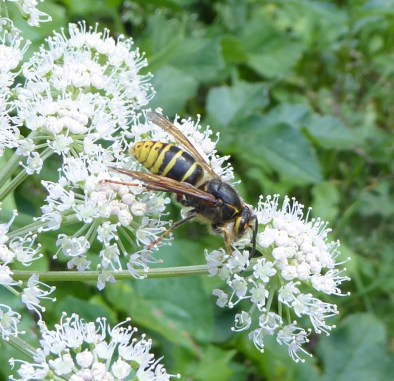
There were plenty of
other insects feeding on the flower heads Two fairly
familiar hoverflies:
Myathropa florea (particularly common
today)
Episyrphus balteatus (the Marmalade
fly).
Eristalis
pertinax (?) - from the pattern on the abdomen
- rather than Drone Fly
Tachina fera (?) - a tubby-looking
Louse-fly with an orange abdomen with a dark line down
the centre.
Common Darter
(male) on a grass spikelet.
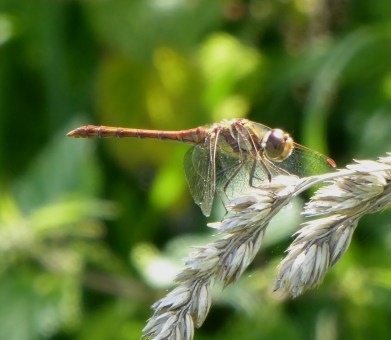
FRIDAY
AUGUST 11 - 2017
Railway
Wayside
Sorry, no blog
for the past few days, but weather has been bad and I
have been doing other things! Today it our 55th
wedding anniversary and we had a little celebration,
but I did manage to get out this afternoon.
I had a quick look at the wayside to the north of
Emsworth Railway Station where the flowers are now
going over and setting seed for the next generation.

But the area remains
very attractive to humans, like me, and to
butterflies. This site is usually good for Common
Blues though the ones I saw today were looking
decidedly worn, the end of the summer brood of adults.
However, here in the south we sometimes get a third
brood in early autumn, so there way be fresh ones on
the wing shortly.
Particularly eye
catching are the bright red seed heads of St
John's-wort.
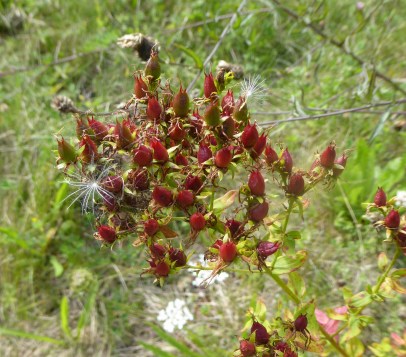
Brook
Meadow
I then had a
stroll through Brook Meadow entering via Seagull Lane
where I was met by a notice warning pedestrians that
the north bridge will be closed from Mon Aug 14 for
repair. The surface of the bridge is in very bad
condition and this job has been on the books for some
while.

I paid particular
attention to the Great Willowherb which, in
addition to the last of the flowers, is adorned with
long seed pods which are just opening to release the
fluffy seeds which float on the wind.
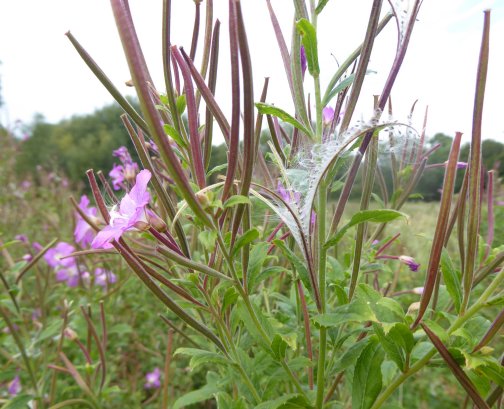
Here is a close-up of
the seeds emerging from the pods.
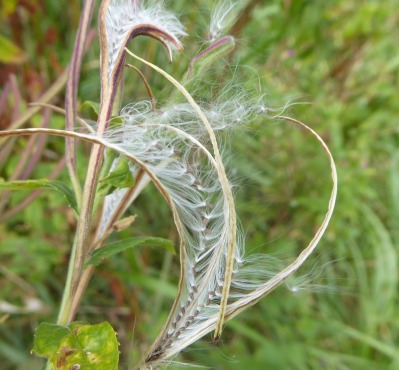
Meanwhile, Hemp
Agrimony is still in full and glorious flower.
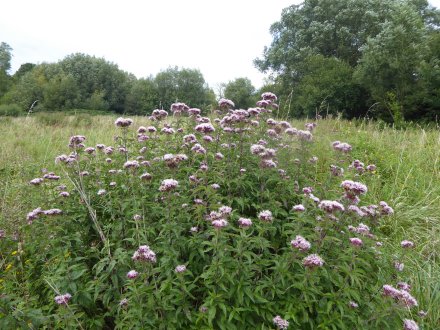
I managed to find just
one Strawberry Clover fruit that had been
missed during the inadvertent cutting of the path
around the Lumley area - the only place that
Strawberry Clover grow on the meadow. Not to worry as
they will no doubt come up again next year as it is a
perennial plant.
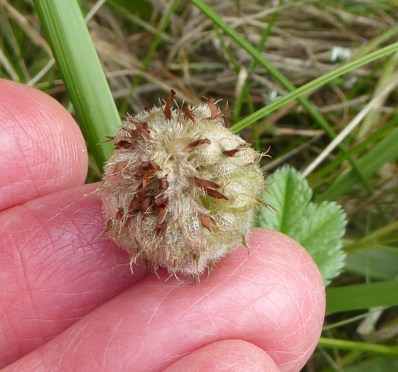
I noticed a couple of
flies with long thin and clearly marked bodies and
short wings feeding on the flower heads of Hogweed.
Consulting my insects guide they look like Soldier
Flies (Stratiomyidae), possibly Chrysotoxum
festivum? Can anyone help?

TUESDAY
AUGUST 8 - 2017
Garden
birds
Currently we
have a good number of birds visiting the garden
virtually all day long. So far this week I have logged
1 Blackbird, 1 Blue Tit, 1 Chaffinch, 7 Collared Dove,
1 Dunnock, 10 Goldfinch, 2 Great Tit, 1 Greenfinch, 4
Long-tailed Tit, 1 Magpie, 16 Starling.
Starlings (mostly juveniles) are certainly the
most entertaining of the birds, hanging onto the fat
ball feeders, squabbling on the ground, etc.
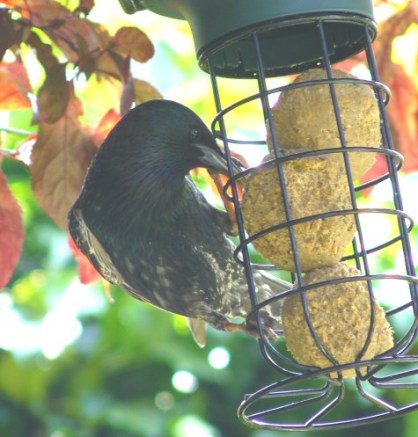
As shown in the chart,
Starlings have made a remarkable recovery in my garden
over the past 3 years, following 6 years of virtual
drought (2009-2014) when I hardly ever saw one. This
year looks to continue the upward trend, though we are
unlikely to reach the heady heights of the early
2000s.

But my favourite bird
of the moment must be the Long-tailed Tits
(again mostly juveniles). A family of four young
birds have been regular on the bird feeders, liking
both the sunflower hearts and the fat balls, though
they also wander around the garden looking for insects
on the shrubs. At times they come really close to the
house. All photos taken through closed windows.
Brook
Meadow
Brian Lawrence
had a quick look around the meadow today and got a
couple of interesting shots. A Ladybird with only one
wing casing and a Common Blue perching on top of what
looks like a shield bug. I have never seen either of
these events before, have you?
MONDAY
AUGUST 7 - 2017
More
Hedgehogs
Romney Turner
is getting regular visits from two Hedgehogs (twins)
to the feeding tray in her garden in the evening. They
make several visits until the food is all gone, or
until one of the larger hogs polishes it off first.
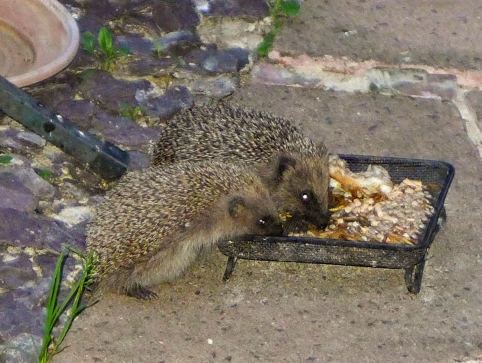
Romney also has a
little Wood Mouse which has discovered the Hedgehog
food tray and often nips in for a snack before they
arrive. She says the mouse really can move which made
getting the pics difficult without spooking the little
thing.
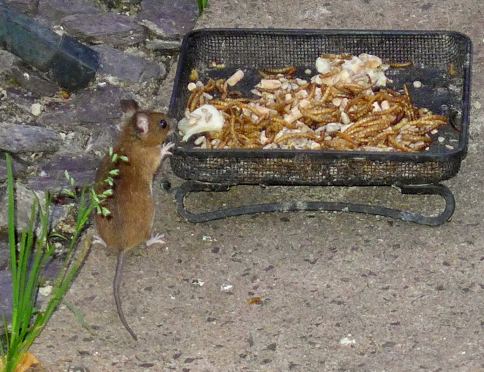
SUNDAY
AUGUST 6 - 2017
Brook
Meadow work session
I went over to
the meadow this morning for the regular first Sunday
in the month conservation work session attended by 9
volunteers and led today by Ian Newman. The main job
involved mowing and raking the paths.
I asked the group to recut the two experimental
cutting areas in the north meadow. These two areas
will be regularly cut to discourage coarse grasses and
allow the more delicate flowering plants. It should be
interesting to see what comes up. The southern area is
looking quite promising with 25 species recorded at
the last count.

Wildlife
observations
I also asked
the volunteers to clear the Jubilee Oak trees on the
Seagull Lane patch which were getting engulfed by
dense vegetation. The young ones we planted for the
Jubilee in 2012 are growing fast. Here is the smallest
one (planted by my wife) which is already 6 feet tall.
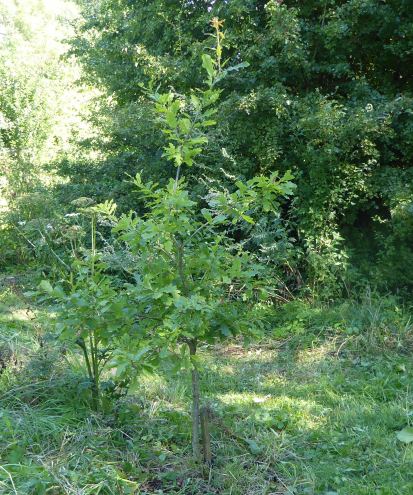
They all have a good
crop of acorns and spangle galls on the leaves.
One of the volunteers
told me she had seen three Hedgehogs near the
Lumley gate during the past week. I have had two in my
garden. Are they doing particularly well this year, I
wonder?
Dan told me that David
Gattrell had seen a Water Vole with a baby vole
at the top of Peter Pond near the Lumley Stream. I
did walk over to Peter Pond this morning to check the
location of the sighting, but could not find David. In
any case, this is very good news as it means we still
have Water Voles not far away from the River Ems on
Brook Meadow. Please come back!
I was very pleased to
find some Prickly Lettuce plants in flower on
the edge of the northern experimental cutting area.
This is a rare plant on Brook Meadow and our first
record for two years. It is not an easy plant to
photograph as this attempt of mine clearly
demonstrates.
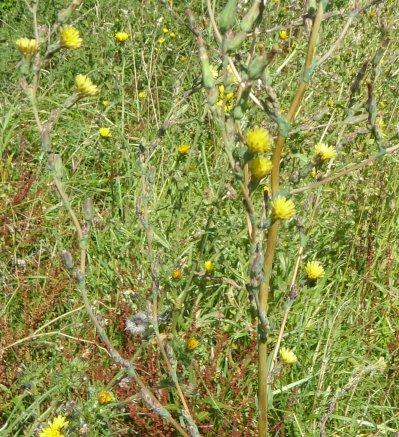
I heard my first
autumn song of the Robin. Butterflies included
Red Admiral, Large White, Comma, Speckled Wood, Meadow
Brown and Gatekeeper.
The Mallards on
Peter Pond are all in eclipse, which means both sexes
have the same brown plumage. The best way to
distinguish them is by the colour of their bills;
males have yellow bills and females brown.

Spiders
In response to
my puzzlement in yesterday's blog entry over the
Garden Spider (Araneus diadematus)
without a cross on its back, Ralph Hollins referred me
to Nick's 'Spiders' as a great source of online info
on spiders. In it, Nick says "Araneus diadematus is
one of the most common and best known orb weavers. It
is easily identified by the distinctive white cross on
the abdomen, although in some specimens it is
indistinct or missing."
See . . . http://www.nicksspiders.com/nicksspiders/araneusdiadematus.htm
Warblington
shore
Peter
Milinets-Raby had the company of John Norton this
morning for his walk around the Warblington shore.
They went on to briefly visit Hayling Oysterbeds as
well (6:27am to 10:17am tide pushing in). Here are
their main observations:
The hedgerow behind Conigar Point: Pheasant female, 2
Whitethroat, 1 Willow Warbler.
Tamarisk Hedge: 6 Long-tailed Tit, 4 Willow Warbler
(some early autumnal movement this morning), 2 juv
Reed Warbler.
Conigar Point: 1 Greenshank, 2 Common Tern, 1 Stock
Dove, 2 Lesser Black-backed Gull, 1 adult winter Med
Gull, 1 Black-tailed Godwit, 1 Swallow, 1 Common
Gull.
Off Pook Lane: 4 Greenshank (RG//- + YY//- & B//R
+ LO//-), 22 Black-tailed Godwit, 2 Whimbrel.
Warblington cemetery:
Fifteen wonderful minutes with a very obliging
Weasel. Tricky to photograph as it dashed in and
out of the gravestones before settling down for five
minutes for some amazing views! Here are a couple of
photos from Peter (on the left) and John (on the
right).
Langstone Mill Pond: 5
Dunlin, 120 Redshank, 1 Whimbrel, 3 Common Gull, 26+
Little Egrets (mostly juvs), Female Tufted Duck with 7
ducklings, 1 Little Grebe, 4+ Willow Warbler in the
Alders with 1 Chiffchaff and a 1 Sedge Warbler.
Cetti's Warbler (one burst of song).
Hayling Oysterbeds: One very nice Wasp Spider,
2 Whimbrel, 24+ Common Tern, 7 Dunlin, 14 Ringed
Plover, 5 Turnstone, 1 Greenshank, 1 Great
Crested Grebe, 310+ Oystercatcher, 1 Swallow, 1+
Whitethroat, 23 Mute Swan off the Southmoor shore.
Wasp
Spider . . . Turnstone
SATURDAY
AUGUST 5 - 2017
Brook
Meadow
Just a few
photos from this morning's walk through Brook Meadow.
I was initially puzzled by this spider, which appeared
to be a standard Garden Spider (Araneus
diadematus), but did not have the usual cross on its
back.
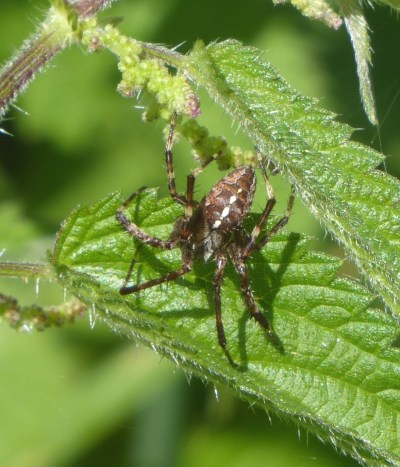
Some of the Hogweed
flower heads were covered in tiny black flies. I've no
idea what they are.
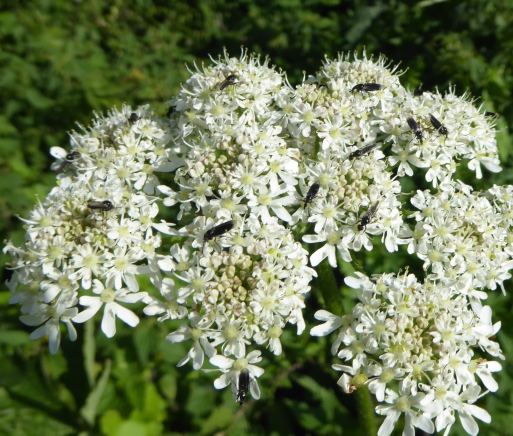
Several Common
Darter dragonflies were chasing and occasionally
perching on the river near the south bridge.
Here is a male with bright red body.
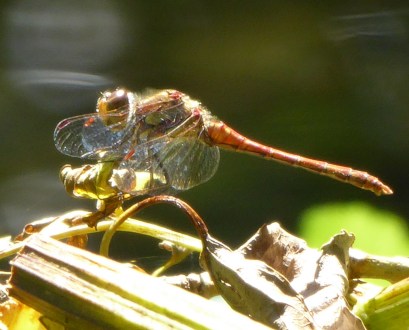
A Drone Fly and
what looks like hoverfly Myathropa
florea.
Mystery
moth
Andy Brown
says he regularly looks at this blog and enjoys the
varied subjects posted. Thanks, Andy. He is keen on
moths and says the micro moth that I photographed on
Brook Meadow on Aug 3 is Common Nettle-tap
(Anthophila fabriciana) . As its mane
suggests the main foodplant of the larvae is Nettle,
though here the mature insect is feeding on
Hogweed.
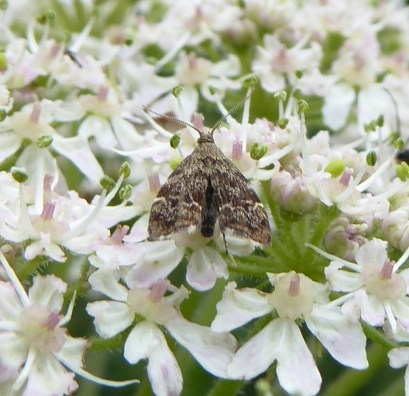
Andy's blog is at . .
. https://hortonheathmoths.wordpress.com/blog/
FRIDAY
AUGUST 4 - 2017
My
'beetle' is a bug
This morning I
had a email from one of my wildlife gurus, John
Norton, who said he was a bit surprised that I could
not tell the difference between beetles and bugs!
Nothing should surprise him about my knowledge or lack
of it. John said the photo on yesterday's blog, which
I thought might be a beetle, was a final instar nymph
of the Common Green Shieldbug.
See . . http://www.britishbugs.org.uk/heteroptera/Pentatomidae/palomena_prasina.html

John attached a pic of
a Birch Shieldbug that he photographed in the
Alver Valley, Gosport yesterday.
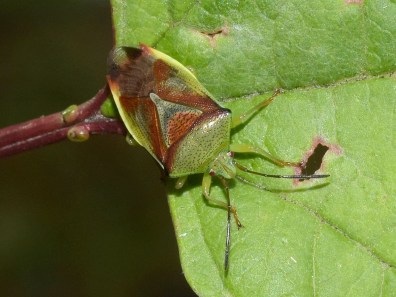
Brook
Meadow
Maurice Lillie
went around the meadow with his trusty camera on this
sunny and windy afternoon. Here is a selection of the
photos he sent to me. He loved the black two-spotted
Harlequin Ladybird with brilliant camouflage
even when not on a blackberry. Others shown here are a
late worker Honey Bee with bulging pollen sacs,
a very green Meadow Grasshopper (I have never
seen one that green) and a pair of Red-Headed
Cardinal Beetles doing what they do best on their
favourite flowers.
I also had a walk
around the meadow later this afternoon with the warm
sun shining low through the trees. As yesterday there
were many insects on the Hogweed umbels, but what
caught my eye was a lengthy 'scrap' between a Red
Admiral and a male Beautiful Demoiselle.
Here are the two combatants resting after the action,
neither none the worse for their mini encounter. What
was going on? Maybe a territorial dispute.
THURSDAY
AUGUST 3 - 2017
Brook
Meadow
I went onto
the meadow this morning mainly to try out my new Lumix
TZ70 camera which I got from Amazon to replace the one
that I irreparably damaged yesterday. Amazon's next
day delivery service is really quite astonishing. I
mainly concentrated on taking close-ups of insects on
Hogweed flower heads, but the strong wind made it
doubly difficult. However, I was pleased with the
camera and the results were, much as with the old one,
some fairly good shots among plenty of rubbish ones.
As always, there were
lots of Red-headed Cardinal (Soldier) Beetles and
several hoverflies on the Hogweed flowers including
Drone Fly (Eristalis tenax) and
Syrphus ribesii.
Common Wasps
were also on the Hogweed along with a small black
fly, much small than a standard Bluebottle which I
think could be one of the parasitic flies in the
family Trachinidae.
Also a small moth .
Help appreciated.

Other sightings/photos
included a Dark Bush-cricket and an
unidentified tiny beetle (?) resting on leaves
with quite distinctive markings, but which I could not
find in my books.
A Bumblebee
(possibly Bombus pascuorum) was on
Common Comfrey and a Harvestman hiding away in
the vegetation.
On the plant front I
was really surprised to come across a single flowering
spike of Agrimony alongside the path on the
west side of the north meadow - the first ever
Agrimony I have seen on the main Brook Meadow site.
The only other ones were all on the Lillywhite's patch
to the south of the Gooseberry Cottage garden, which
is, strictly speaking, not part of Brook Meadow. I
think I can just make out another Agrimony plant next
to the flowering one in the photo, so I will keep an
eye on these.
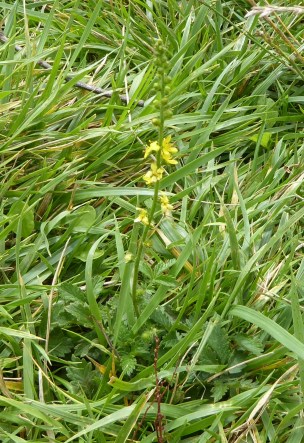
TUESDAY
AUGUST 1 - 2017
Bridge
Road Wayside
I was
surprised, but also delighted, to see that the wayside
in Bridge Road car park had been cut. The council
cutting team has done a very thorough job, all the
verge has been cut and some of the bushes also trimmed
back. Well done to Jane Brook for organising this. The
arisings will remain in situ for a few weeks to allow
seeds to drop. Then they will be raked up presumably
by volunteers.
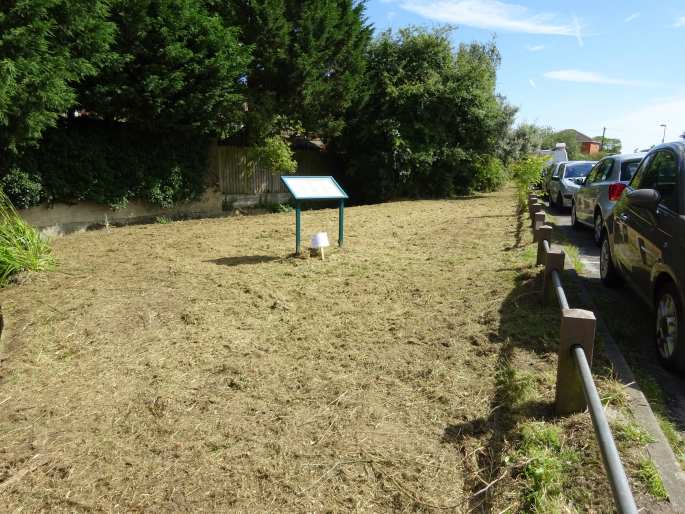
The cutting had
produced a lot of minced up litter that I had missed
in my last litter pick, so I went round again and
filled one full bag of general waste and two extra
bags of broken tiles from fly tipping. Exhausting
work, but good to have it done. I took this selfie
with the camera balanced on the bonnet of a parked
car.
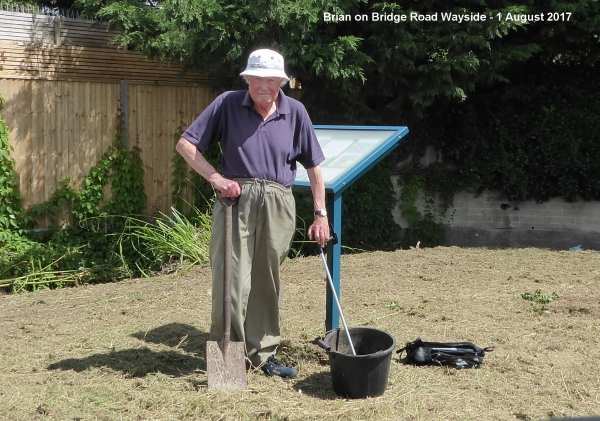
In fact, it turned out
to the the last one I shall take with that camera - my
favourite Lumix TZ70 - as in doing a second photo a
gust of wind blew the camera off the car bonnet and it
crashed zoom first onto the hard surface of the car
park never to operate again. A lesson learned, but an
expensive one, as to repair it would cost almost as
much as a new camera!
There was not much to
see on the wayside, though I noticed a good crop of
apples on the tree in the central shrubbery, which
should be sweet when ripe.
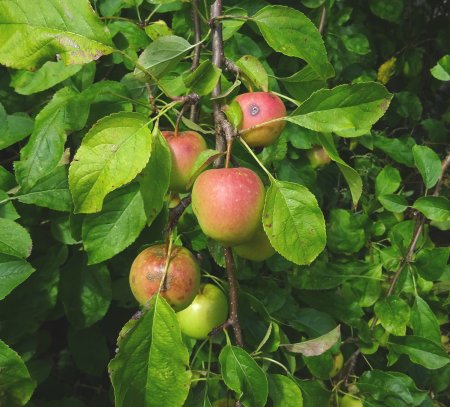
There is also a very
nice display of Bulrushes in flower on the edge
of the stream with 29 brown flower spikes. Here are
just a few of them.
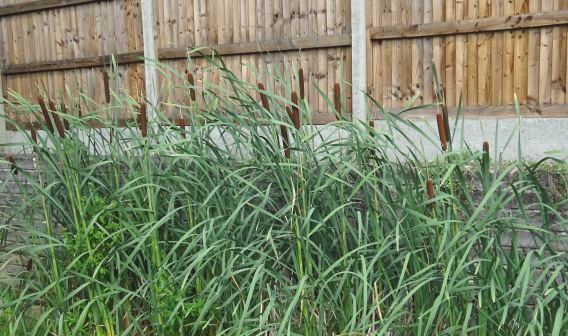
Colin's
gallery
Colin Vanner
sent me a few of his recent images mostly taken at
Farlington Marshes. Here is a selection of Colin's
quite outstanding photos. Greenfinch, Blue Tit
snoozing (?) and Kingfisher with crab.

For
earlier observations go to . . . July
18-31